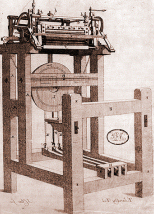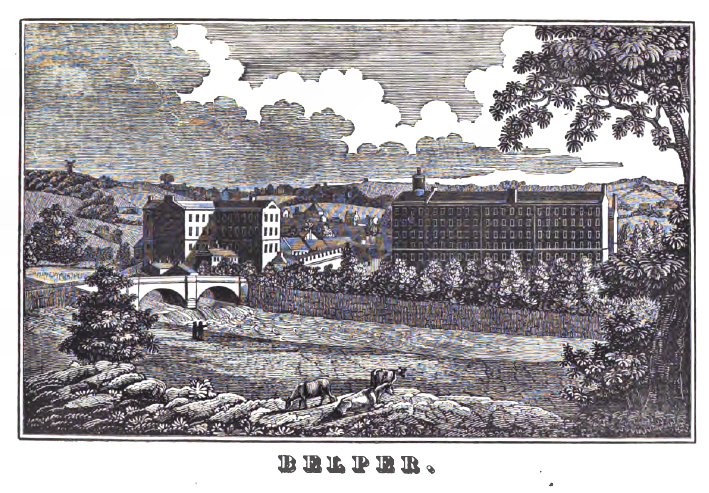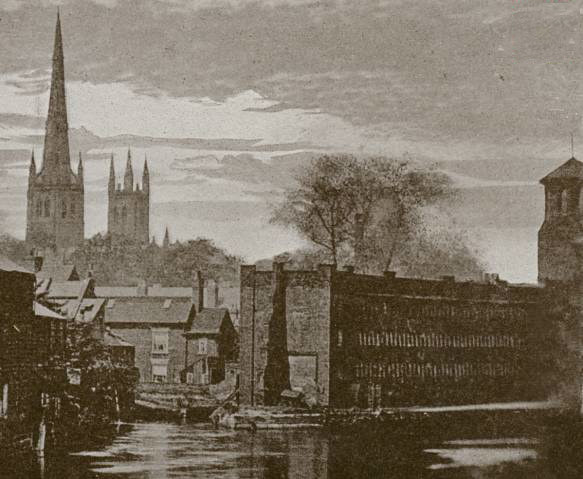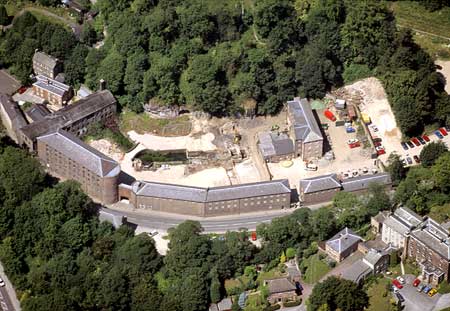
"The Mirror of Literature, Amusement and Instruction"
Containing Original Essays, Historical Narratives,
Biographical Memoirs, Sketches of Society, Topographical Descriptions,
Novels and Tales, Anecdotes,
Select Extracts from New and Extensive Works,
Poetry, Original and Selected,
the Spirit of Public Journals, Discoveries in the Arts and Sciences,
Useful Domestic Hints Etc Etc Etc.
VOL. XIII.
1829
Page 248:
Belper
I proceeded to Belper, eight miles, to view the superb establishment of the Messrs. Strutt, as cotton spinners. The excellent road, which continues to Matlock, and the north, lay through the most delightfully variegated country which I had seen since I left Hertfordshire.
The village of Duffield, in a valley of the Derwent, with houses on the steep eastern bank, and woods to the top, is one of the prettiest to be seen. On crossing the river, I beheld long lines of cottages, built for the residence of the families employed in Messrs. Strutts' smaller factory at Milford.
Passing this, the extensive but straggling and picturesque town of Belper, covered the eastern hill. What remains of the old town, is not a tithe of the present one, and the whole is now supported by Messrs. Strutts' gigantic mills.
I approached these with mingled pleasure and astonishment A manufactory, in such hands, presented none of the usual drawbacks on one's feelings. They never discharge their workmen; and good conduct is a life interest in comfort! The picturesque beauty of the situation, the height and extent of the buildings, and the increase of the busy throng, as I entered the yard, was exhilarating. The effect grew as I approached, for the distance of two or three hundred yards, the noise, produced by the united rattling or thousands of small wheels, was like the sound of a hail storm on a large skylight, or the fall of an immense sheet of water.
There are five oblong factories and two circular ones. The five are six stories high, with ten or twelve windows on each story, so that in the five there are, at least, as many regular windows as days in the year. The circular buildings have forty or fifty more.

East Mill, North Mill and West Mill from the River Garden 20th Century
In this establishment, and at Milford, Messrs. Strutt employ, at present, about 1,300 hands of both sexes and different ages, and spin about 18 tons, or 40,000 lbs. of cotton per week. The average fineness may be taken at 20 hanks to the pound, and hence, as each hank is 840 yards, or nearly half a mile, every pound is nearly ten miles, and the whole, about 400,000 miles are produced in about sixty-six working hours. In round numbers, this is 6,000 miles per hour, or 100 miles a minute. What an astonishing effect of the combination of mechanism! What an inconceivable miracle, if it might not be witnessed by their favour at any time!
Nor should it be forgotten, that every fibre passes through no less than ten sets of machinery, hence, the united spindles and threads travel through 1,000 miles a minute. The noise of their united frictions and collisions, and the united hum of thousands of little spindles, each revolving 4,000 times a minute, may, therefore, be accounted for, but can never be conceived, unless heard in the midst of them.
It would be tedious to dwell on the well-known process of cotton spinning ; but as this manufactory produces the cleanest and most perfect yarn made in England, of its numbers from 6 to 100, it may be worth while to state, that this perfection appears to arise, from the systematic perfection of all the machines, and from the astonishing cleanness of every part of this great factory.
The wheels are as bright as the grate of a good housewife's drawing-room ; every action is complete in its way, and though cotton is a dusty article, yet I no where saw either dirt or dust. At the same time, order prevails throughout, for as the main shaft gives no respite to the carding, roving, and spinning machines, so every attendant diligently and silently watches the lines of bobbins which are performing their miraculous evolutions, while the other apparatus are correcting and regulating the stages and steps of the production.
The whole is turned by eight or nine water wheels, of about twenty-four feet diameter, and twenty feet in length. The fan is about twenty feet, and the admirable contrivances of revolving balls (adopted in the steam-engine) are affixed, to render the power uniform, by varying the depth of the falling stream. In truth, it is one of the features of the entire establishment, that all that can be performed by machinery, is so performed, and that the machinery is the very best for its purpose, and in many instances which I witnessed, as true, as decided in its action.
After the thread is wound into hanks, it is bleached at a distinct manufactory for that purpose ; but as bleaching is a mere chemical operation, and the means are either known and not curious, or secret, and not proper to inquire about, I did not visit this branch of the establishment.
The first of the works on this spot, was built by Mr. Jedediah Strutt, father of the brothers, William, George, and Joseph, about fifty years since. Arkwright invented the spinning machines, while a barber's apprentice. He was joined by one Need, and they expended £14,000. with uncertain success. Wright, the banker, of Nottingham, hesitated to make further advances, and, at this juncture, they were joined by Mr. Jedediah Strutt, a careful man, with the necessary credit or capital, and the result was, the realization of princely fortunes, and the enriching even the nation itself.
On the expiration of their partnership, Arkwright went on by himself at Cromford, and the Strutts for themselves at Belper. A spirit of detraction would make it appear that Arkwright stole the invention of another, but Mr. William Strutt, who knew him well, and is a competent judge on such subjects, assured me that Arkwright was a man of very superior talents as a mechanic, and quite equal to such an invention.
I saw two portraits of him in Mr. Strutt's house, and no higher proof could be given of his personal respect for Arkwright, while he never failed to speak of him with enthusiasm, as a man of original talents.
Derby Silk Trade.
Silk throwing is a considerable trade in Derby. Sir Thomas Lombe's famous machinery has not, however, been used for some years, but improved machinery, which performs twice the work, in less room, is now adopted.

Derby Silk Mills before the 1910 Fire
The chief throwsters are Messrs. Bridget, Taylor, Adcock, Butterworth, Moore and Gibson, Devenport and Forster. The silks, as imported, chiefly front Bengal and China, are in what are called books of 10 lb. of which ten form a bale, and the business of the throwster is to wind it, from the plats or skeins upon bobbins ; and from these, it is twisted into two, three. or more threads.
The price for throwing is from 1s. 9d. to 2s. for Bengals, and from 2s. at to 3s. per lb. for China. About 1,500 lbs. a week are thrown, employing from 1,000 to 1,200 men, women, and children. The price used to be 4s. a lb. but a fall has taken place, within the last fifteen years, in this article of labour, as well as in every other.
I heard much from all the manufacturers of Derby, of the mechanical ingenuity of Mr. James Fox, of Chester Road, on the banks of the Dement. I paid him a visit, and beheld his powerful iron lathes, twenty-four feet long; used by machine makers for planing iron. Here I saw iron cut in groves or squared with great simplicity, by duly adjusting the velocity so as to generate no heat, for a velocity, which generates heat, destroys the tool. These lathes, Mr. Fox makes for machinists in all parts of the kingdom, and gets from £200. to £700 for them. The castings are made at Morley Park ; and I was sorry to learn that they are now delivered at £7. a ton instead of £30. the usual and legitimate price. In truth, the depression of the iron trade is as great or greater than that of the other staples of the kingdom.
The number of cotton frames employed by the above, is from 3,000 to 4,000 dispersed over the town and country ; and the number of silk frames is about 1,000. The average earnings of the cotton hands are from 7s. to 10s. per week, but many frames are worked by young persons both male and female. The silk hands earn about 12s. or 15s.
Petrifaction Manufactory
A manufactory, at once local and elegant, exists at Derby, which excites the attention and loosens the purse-strings of most strangers. It is the spar-manufactory of Mr. Hall, and in it, he converts the petrified sports of nature, in the Derbyshire hills, into the luxuries of civil life. Those in London, who desire to see the products of these works, may behold them at Mawe's, in the Strand; but all, who visit Derby, will not fail to call upon Mr. Hall, who is as courteous as he is ingenious. Amythistine and other spars, white and variegated marble, alabaster, &c. are here formed in a series of workshops, aided by a steam engine, into vases, columns, obelisks, &c. &c. Tasteful statuaries are also employed, in converting the same materials into dogs, horses, sheep, cows. &c. for chimney ornaments ; and Mr. Hall has likewise imitated the best vases, and some of the structures of Egypt, with exact transcipts of their inscriptions. In these works, in polishing, sawing, fashioning, &c. he employs numerous hands ; and persons, whom he may indulge, with a view of the details, will be instructed and gratified.
The Arkwrights
 Cromford is an immense establishment ; but being inferior in magnitude to Belper, and of the same description, I forbear to enlarge upon it. Here the late Sir Richard Arkwright established the first cotton-spinning mill, and from the poverty of a barber's apprentice, became one of the wealthiest merchants in the united kingdom.
Cromford is an immense establishment ; but being inferior in magnitude to Belper, and of the same description, I forbear to enlarge upon it. Here the late Sir Richard Arkwright established the first cotton-spinning mill, and from the poverty of a barber's apprentice, became one of the wealthiest merchants in the united kingdom.
The concern is now carried on by his son, and I found that his work-people were in the same state of comfort, as those of the Messrs. Strutt.
The present Mr. Arkwright, son of Sir Richard, is between seventy and eighty, and by the poser of unparalleled capital and habits of frugality, he is considered the most wealthy person in Europe. I heard his accumulations estimatedat six, eight, and even ten millions ; And he spends but 2 or £3,000. per annum.
He has eight children, and provides liberally for them, and I heard some anecdotes of his munificence to the deserving, but do not consider myself at liberty to repeat them. His habits lead him to continue in business, though the profits are now trifling. Those of his father and his own, formerly, were 2 or 300 per cent, but competition has now rendered them nearly nominal.






